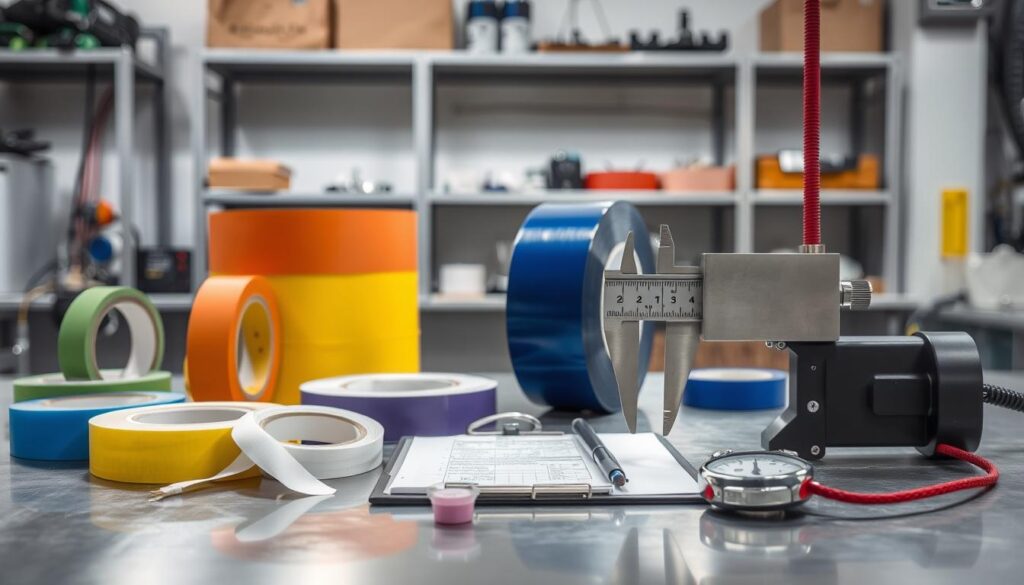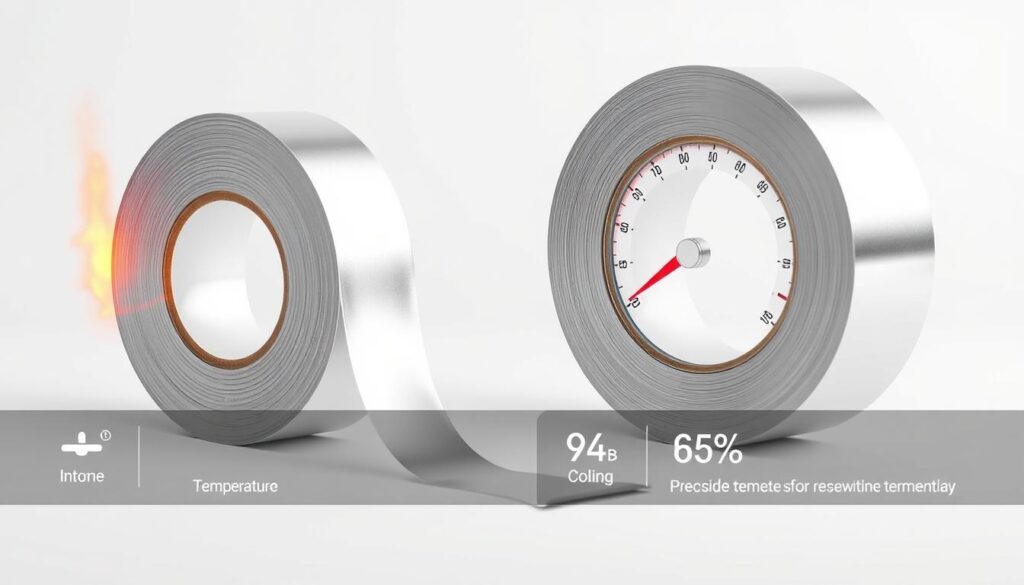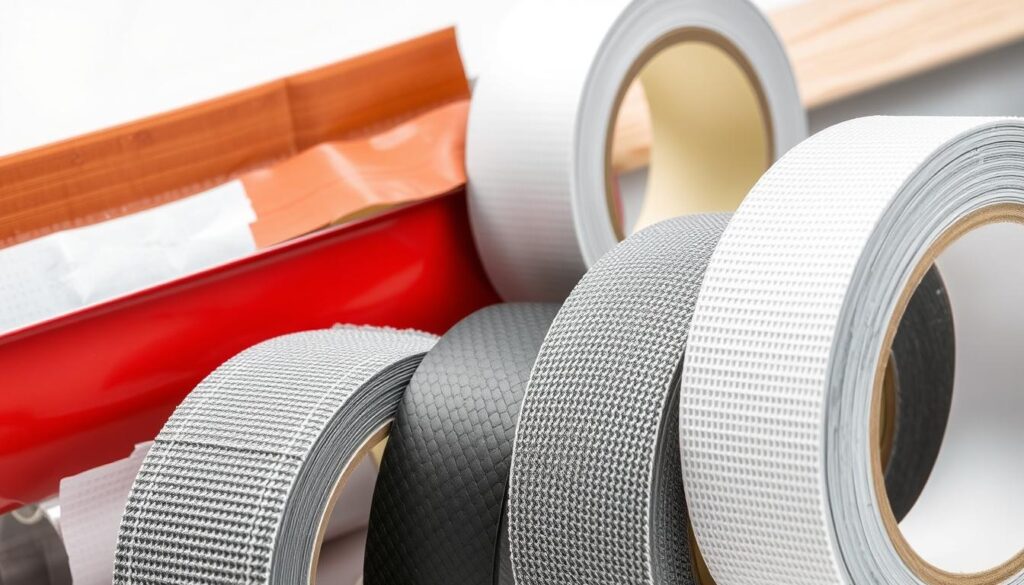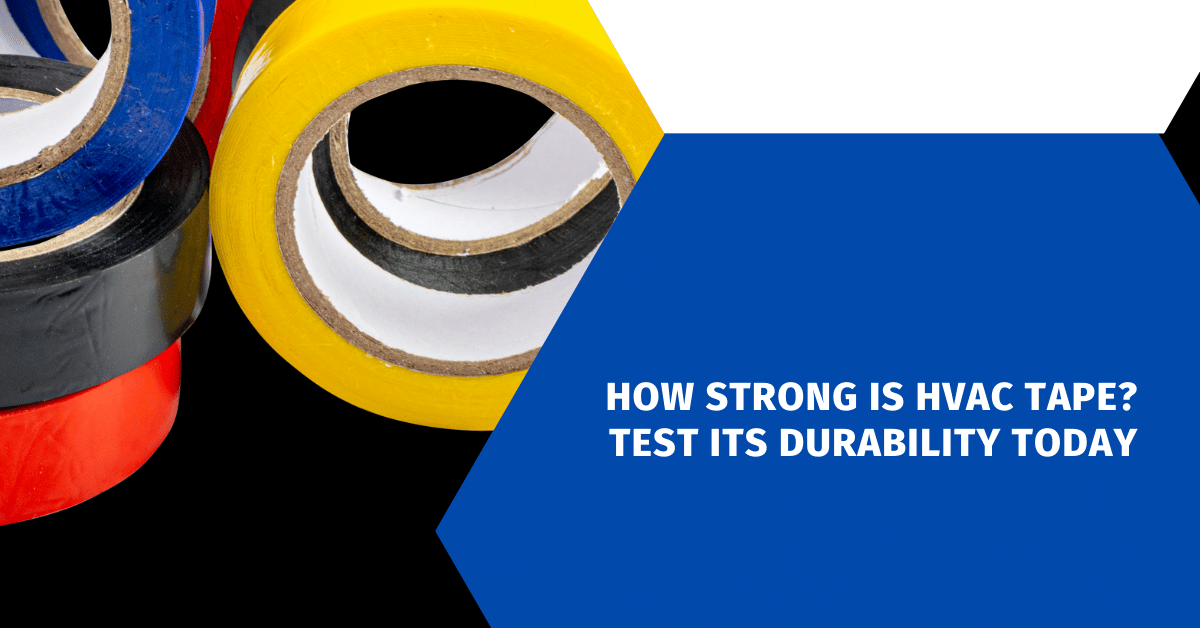Affiliate Disclosure
HVAC Guide Guys is a participant in the Amazon Services LLC Associates Program, an affiliate advertising program designed to provide a means for sites to earn advertising fees by advertising and linking to Amazon.
How Strong Is HVAC Tape? Ever thought about what keeps your HVAC system’s ductwork sealed and working well? The answer is the amazing strength of HVAC tape. But how strong is it when tested to the limit?

HVAC tape is more than just a sticky fix. It’s a specialized solution that can handle extreme temperatures and keep air leaks out. It’s key to your heating and cooling system’s success.
Both pros and DIY fans need to know what makes HVAC tape strong. It’s all about the materials and adhesives used. These tapes are vital for your system’s top performance.
Key Takeaways
- HVAC tape is engineered for maximum durability and performance
- Proper tape selection prevents air leaks and system inefficiencies
- Strength testing ensures reliable HVAC system connections
- Temperature and environmental factors impact tape performance
- Professional-grade tapes offer superior sealing capabilities
Table of Contents
Understanding HVAC Tape Strength Fundamentals
Choosing the right HVAC tape is key for both professionals and homeowners. The tape’s strength and reliability come from several important factors.
Professional HVAC technicians know that not all tapes are the same. The right tape can greatly improve system performance and lifespan.
Types of HVAC Tape Backing Materials
Backing materials are vital for tape performance. Each material has its own benefits:
- Foil backing: Provides exceptional heat resistance
- Film backing: Offers superior moisture protection
- Composite backing: Combines multiple material benefits
- Cloth-based backing: Delivers flexibility in challenging environments
Common Adhesive Technologies
The adhesive layer is what makes your HVAC tape perform well. There are several key technologies:
- Acrylic adhesives: Best for long-term, consistent performance
- Butyl-based adhesives: Excellent for sealing and waterproofing
- Rubber-based adhesives: Provide quick initial stick and flexibility
Strength Ratings Explained
Strength ratings help you pick the right HVAC tape. Manufacturers give ratings for:
- Adhesion strength: How well the tape sticks to surfaces
- Tensile strength: The tape’s resistance to breaking under tension
- Temperature range: Performance capabilities in different environments
By looking at these basics, you can choose the best HVAC tape for your needs.
Explore Our HVAC Shop
Looking for top-rated HVAC tools, parts, and accessories? Visit our shop and find the perfect solution for your needs.
Visit the ShopHow Strong Is HVAC Tape: Testing Methods and Standards
Professional HVAC installations need strong testing for industrial-grade HVAC tape. Knowing the detailed testing process helps pick the best long-lasting HVAC tape for important jobs.
Industry standards require many precise tests to check tape performance. These tests make sure your tape meets high quality standards. The main tests look at several key areas:
- Adhesion Level Testing: Checks how well the tape sticks to different surfaces
- Shear Strength Evaluation: Sees how well the tape resists sliding or coming apart
- Tensile Strength Assessment: Tests the tape’s strength against pulling forces
- Burn Resistance Verification: Checks fire safety and material durability
- Humidity and Mold Resistance Test: Confirms performance in tough environmental conditions
These tough tests mimic real-world situations, making sure industrial-grade HVAC tape works well. Manufacturers put their products through extreme tests. They check how well the tape holds up under stress.
Proper testing ensures your HVAC tape will work well in tough professional settings.
Choosing tape that passes these detailed tests keeps your HVAC system running smoothly and lasting longer. You can rely on certified tapes that show top performance in many important areas.
Essential Components of Heavy-Duty HVAC Tape
Knowing what makes up high-quality HVAC tape is key for reliable performance in heating, ventilation, and air conditioning systems. Both professional contractors and DIY fans need to understand the main parts of a good sealing solution.
A top-notch HVAC tape has several advanced parts that work together. These parts decide the tape’s strength, how long it lasts, and how well it works under tough conditions.
Foil and Film Backing Comparison
Choosing the right HVAC tape means knowing about backing materials. Each type has its own benefits:
- Foil Backing: Great for reflecting heat and keeping moisture out
- Film Backing: Best for fitting well on uneven surfaces
- Aluminum Foil: Great for very hot places
- Polymer Films: Perfect for sealing flexible ducts
Adhesive Layer Technology
The adhesive layer is the core of any good HVAC tape. New adhesive tech aims to make strong, lasting bonds on different surfaces.
| Adhesive Type | Key Characteristics | Best Application |
|---|---|---|
| Acrylic | Stays strong in high temperatures | For permanent jobs |
| Rubber-based | Grabs surfaces quickly | For temporary fixes |
| Silicone | Works in extreme temperatures | For industrial HVAC setups |
Reinforcement Materials
Reinforcement materials are vital for making HVAC tape strong. Fiberglass and polyester scrim help the tape resist tears and stay strong.
By picking and mixing these key parts, makers create HVAC tapes that meet today’s heating and cooling needs.
Explore Our HVAC Shop
Looking for top-rated HVAC tools, parts, and accessories? Visit our shop and find the perfect solution for your needs.
Visit the ShopTemperature Resistance and Performance Range

It’s important to know how strong HVAC tape is in different temperatures. This is key for keeping seals tight and insulation working well. When picking HVAC tape, think about how it will handle various environmental challenges.
The strength of HVAC tape greatly depends on its ability to handle extreme temperatures. Experts say to choose tapes made for specific climates for the best results. The right tape keeps its stickiness in both very hot and very cold conditions.
- Cold Temperature Performance: Look for tapes rated for temperatures as low as -20°F
- Heat Resistance: High-quality tapes can maintain integrity up to 200°F
- Thermal Expansion Tolerance: Seek tapes with flexible backing materials
Different HVAC settings need special tape solutions. Outdoor jobs need tapes that can handle very high and very low temperatures without losing their stickiness. Indoor jobs might not need such extreme ratings but must perform well consistently.
Pro Tip: Always check manufacturer specifications for precise temperature range capabilities before selecting your HVAC tape.
Things that affect how well HVAC tape holds up in changing temperatures include:
- Backing material composition
- Adhesive chemical structure
- Environmental exposure duration
- Surface preparation
Choosing the right tape means your seals will last longer and avoid system failures due to temperature damage.
Pressure Sensitivity and Application Technique
It’s important to know how pressure-sensitive durable HVAC tape is. This knowledge helps you get the best results from your heating and cooling systems. The tape’s quality matters, but so does how you apply it.
Installing the tape right is key to its success. You need to prepare well and apply it carefully. This is what makes the tape seal airtight.
Proper Installation Methods
To get a strong bond, pay close attention to detail. Here are some essential steps:
- Clean the surface well before you start
- Make sure it’s dry
- Get rid of dust, grease, and dirt
- Use a clean, lint-free cloth for the final clean
Surface Preparation Requirements
Good surface prep is the base of a successful tape job. Each material needs a different cleaning method:
- Metal: Use alcohol-based cleaners
- Plastic: A mild detergent solution is best
- Ductwork: Remove old adhesive first
Pressure Application Guidelines
The last step is applying the right pressure. Consistent, firm pressure is key to activating the tape’s adhesive properties. Use a roller or your hand to press down firmly over the whole area.
Pro Tip: Apply pressure evenly and firmly for at least 30 seconds to guarantee maximum adhesion.
Environmental Factors Affecting Tape Durability
It’s important to know how the environment affects industrial-grade HVAC tape. Your HVAC system’s tape needs to handle tough conditions well. This ensures it works for a long time.
Several environmental factors affect how long HVAC tape lasts:
- Humidity Levels: High moisture can weaken tape’s stickiness and strength
- Temperature Fluctuations: Extreme temperatures can make tape materials expand or become brittle
- Chemical Exposure: Tapes in certain places may face corrosive substances that harm their performance
- UV Radiation: Sunlight can damage the adhesive and weaken the tape over time
Experts say to pick industrial-grade HVAC tape made for your environment. Tapes with strong backing and adhesive can better withstand these challenges.
Choosing the right tape is not just about its strength. It’s about finding one that fits your specific environment.
To keep your tape in good shape, try these tips:
- Clean the surface before applying the tape
- Choose tapes rated for your environment
- Check and maintain the tape regularly
- Replace tape that shows signs of wear from the environment
Explore Our HVAC Shop
Looking for top-rated HVAC tools, parts, and accessories? Visit our shop and find the perfect solution for your needs.
Visit the ShopUL Listings and Industry Compliance Standards
Choosing the right HVAC tape is key. It must meet important safety standards. UL (Underwriters Laboratories) listings guide us to ensure the tape’s quality and safety.
Professional HVAC technicians look for specific UL certifications. These standards check the tape’s quality and reliability. They help avoid system failures and safety risks.
UL 181A-P Requirements
The UL 181A-P standard checks HVAC tapes in air systems. It looks at:
- Flame resistance testing
- Mold growth prevention
- Humidity performance
- Static load capabilities
UL 181B-FX Specifications
UL 181B-FX adds more tests for HVAC tape. It checks:
- Impact resistance
- Pressure endurance
- Tension strength
- System collapse prevention
Safety Code Compliance
Good HVAC tape must follow safety codes. It needs to pass many tests. This ensures it works well and safely.
| Certification Type | Key Performance Indicators | Minimum Standards |
|---|---|---|
| UL 181A-P | Flame Resistance | Class 1 Rating |
| UL 181B-FX | Pressure Endurance | 500 Hours Minimum |
| Safety Code | Humidity Resistance | No Degradation |
Choosing UL-listed tapes keeps your HVAC systems safe. They work well in many conditions.
Surface Compatibility and Adhesion Strength

Choosing the right tear-resistant HVAC tape is key. It must match the surface it’s applied to. Different materials in HVAC systems need specific adhesives for the best results and lasting performance.
For aluminum ductwork and sheet metal, you need a reinforced HVAC tape with strong adhesive. These smooth, non-porous surfaces are tough on tape because of the thermal changes they go through.
- Aluminum surfaces require high-tensile strength tape
- Smooth metal surfaces need specialized adhesive technology
- Thermal movement demands flexible yet durable tape solutions
The texture of the surface is also important for tape adhesion. Materials like fiberglass insulation and flexible ductwork need different tapes than metal. Your choice of tear-resistant HVAC tape should fit the specific material to avoid failures.
Several factors affect how well the tape sticks:
- Surface cleanliness
- Material porosity
- Temperature variations
- Mechanical stress
Professional HVAC technicians suggest testing tape adhesion on small areas first. This step ensures the tape works well over time and meets your needs.
Common Applications and Strength Requirements
Knowing how strong HVAC tape must be is key for good installations in heating, ventilation, and air conditioning systems. Each HVAC use has its own tape strength needs. This ensures the system works well and lasts long.
When looking at hvac tape strength, you’ll find several important areas:
- Flexible Duct Sealing
- Insulated Ductboard Connections
- Metal Ductwork Repairs
- Thermal Insulation Joining
Sealing flexible ducts needs tapes with great adhesion and flexibility. How strong is hvac tape in these cases? Top-quality tapes must stick well even when the duct moves and temperatures change.
For metal ductwork, you need tapes with high tensile strength and resistance to the environment. The right tape stops air leaks, cuts energy loss, and holds up to a lot of stress.
When picking HVAC tape strength, consider these:
- Surface material compatibility
- Temperature range
- Moisture exposure
- Expected mechanical stress
Professional HVAC technicians say to pick tapes stronger than the minimum. This ensures your system works well for a long time.
Explore Our HVAC Shop
Looking for top-rated HVAC tools, parts, and accessories? Visit our shop and find the perfect solution for your needs.
Visit the ShopMaintaining HVAC Tape Performance Over Time
Keeping your durable HVAC tape in good shape is key. It’s a vital part of keeping your system running well and saving energy.
Good care can make your HVAC system last longer. Experts say there are a few important steps to keep your tape strong.
Long-term Durability Factors
- Regular visual inspections of tape integrity
- Monitoring environmental conditions
- Checking for signs of wear or degradation
- Protecting tape from direct sunlight and extreme temperatures
Preventive Maintenance Tips
- Schedule professional duct cleaning annually
- Ensure proper surface preparation before tape application
- Use high-quality durable HVAC tape from reputable manufacturers
- Avoid DIY repairs on critical ductwork connections
Signs of Tape Failure
Spotting tape problems early can stop big issues. Look out for these signs:
- Visible tape peeling or lifting
- Air leakage around sealed connections
- Discoloration or brittleness of tape material
- Reduced system airflow performance
“Proactive maintenance is the key to preserving your HVAC system’s performance and longevity.” – HVAC Maintenance Professionals
Following these tips can help your HVAC tape work better for a long time. This ensures your system runs smoothly for years.
Conclusion
Choosing the right HVAC tape is key to keeping your system running well. Knowing about backing materials, adhesives, and environmental factors helps a lot. This knowledge helps you pick the best tape for your needs.
How you apply the tape matters a lot. Make sure surfaces are ready, apply even pressure, and think about the environment. Doing this right can save you from future problems and keep your system working smoothly.
It’s important to check your HVAC tape often. Look for any signs of wear or damage that could hurt your system’s performance. By being proactive and using top-quality tape, you can keep your HVAC system in great shape.
Think of the right tape as a vital part of your HVAC system. Making smart choices can cut down on maintenance costs and improve your system’s efficiency. It also helps protect against environmental challenges.

